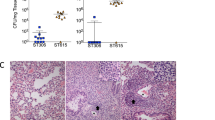Abstract
Various human isolates of type III group B streptococci (GBS) orStreptococcus agalactiae could be divided into two distinct groups (high and low producers) on the basis of their in vitro production of extracellular type-specific antigen (ETSA). The high ETSA producers were shown to be significantly more virulent in mice than were the low producers. In an effort to examine the possibility that purified extracellular products (ETSA, neuraminidase, or protease_ had a significant effect on GBS virulence in the mouse model, mice received either 1.0 ml of organisms intraperitoneally (IP) or 1.0 ml of organisms IP plus 0.1 ml IP of the appropriate purified extracellular products. Only purified ETSA demonstrated a substantial decrease (1.0 log10) in the 50% lethal dose (LD50) values and only for a high ETSA producing strain. Serum from mice infected with a high ETSA producer contained approximately 12.5 μg/ml of the ETSA, whereas serum from mice infected with a low ETSA producer contained no detectable ETSA. These data imply that the two different types of organisms (high and low ETSA producers) have somewhat different mechanisms of pathogenicity in the mouse model.
Similar content being viewed by others
Literature Cited
Baker, C. J., Barrett, F. F., Gordon, R. C., Yow, M. D. 1973. Suppurative meningitis due to streptococci of Lancefield group B: a study of 33 infants. Journal of Pediatrics82:724–729.
Baker, C. J., Webb, B. J., Jackson, C. V., Edwards, M. S. 1980. Counter-current immunoelectrophoresis in the evaluation of infants with group B streptococcal disease. Pediatrics65:1110–1114.
Doran, T. I., Straus, D. C., Mattingly, S. J. 1980. Extracellular antigens of serotype III group B streptococci. Infection and Immunity30:890–893.
Durham, D. L., Mattingly, S. J., Doran, T. I., Milligan, T. W., Straus, D. C. 1981. Correlation between the production of extracellular substances by type III group B streptococcal strains and virulence in a mouse model. Infection and Immunity34:448–454.
Edwards, M. S., Baker, C. J., Kasper, D. L. 1979. Opsonic specificity of human antibody to the type III polysaccharide of group B streptococcus. Journal of Infectious Diseases140:1004–1008.
Farr, R. S. 1948. A quantitative immunochemical measure of the primary interaction between I*BSA and antibody. Journal of Infectious Diseases103:239–262.
Ferrieri, P., Gray, E. D., Wannamaker, L. W. 1980. Biochemical and immunological characterization of the extracellular nucleases of group B streptococci. Journal of Experimental Medicine151:56–68.
Franciosi, R. A., Knostman, J. D., Simmerman, R. A. 1973. Group B streptococcal neonatal and infant infections. Journal of Pediatrics82:707–718.
Gutschik, E., Motles, S., Christensen, N. 1979. Experimental endocarditis in rabbits. 3 Significance of proteolytic capability of the infecting strains ofStreptococcus faecalis. Acta Pathologica Microbiologica Scandanavia, Section B87:353–362.
Hastings, M. J. G., Easmon, C. S. F. 1981. Variations in the opsonic requirements of group B streptococcus type III. British Journal of Experimental Pathology62:519–525.
Hellerqvist, C. G., Rojas, J., Green, R. S., Sell, S., Sundell, H., Stahlman, M. T. 1981. Studies on group B β-hemolytic streptococcus. I. Isolation and partial characterization of an extracellular toxin. Pediatric Research15:892–898.
Holder, I. A., Haidaris, C. F. 1979. Experimental studies of the pathogenesis of infections due toPseudomonas aeruginosa: extracellular protease and elastase as in vivo virulence factors. Canadian Journal of Microbiology25:593–599.
Kaijser, B., Ahlstedt, S. 1977. Protective capacity of antibodies againstEscherichia coli O and K antigens. Infection and Immunity17:286–289.
Kasper, D. L., Baker, C. J. 1979. Electron microscopic definition of surface antigens of group B streptococcus. Journal of Infectious Diseases139:147–151.
Kelly, R. T., Freiff, D., Farmer, S. 1966. Neuraminidase activity inDiplococcus pneumoniae. Journal of Bacteriology91:601–603.
Kjems, E., Perch, B., Henrichsen, J. 1980. Serotypes of group B streptococci and their relation to hyaluronidase production and hydrolysis of salicin. Journal of Clinical Microbiology11:111–113.
Milligan, T. W., Baker, C. J., Straus, D. C., Mattingly, S. J. 1978. Association of elevated levels of extracellular neuraminidase with clinical isolates of type III group B streptococci. Infection and Immunity21:738–746.
Milligan, T. W., Doran, T. I., Straus, D. C., Mattingly, S. J. 1978. Growth and amino acid requirements of various strains of group B streptococci. Journal of Clinical Microbiology7:28–33.
Milligan, T. W., Mattingly, S. J., Straus, D. C. 1980. Purification and partial characterization of neuraminidase from type III group B streptococci. Journal of Bacteriology144:164–172.
Milligan, T. W., Straus, D. C., Mattingly, S. J. 1977. Extracellular neuraminidase production by group B streptococci. Infection and Immunity18:189–195.
Pavlovskis, O. R., Wretlind, B. 1979. Assessment of protease (elastase) as aPseudomonas aeruginosa virulence factor in experimental mouse burn infection. Infection and Immunity24:181–187.
Pollack, M. 1976. Significance of circulating capsular antigen in Klebsiella infections. Infection and Immunity13:1543–1548.
Reed, L. J., Muench, H. A. 1938. A simple method of estimating fifty percent endpoints. American Journal of Hygiene27:493–497.
Straus, D. C., Mattingly, S. J., Milligan, T. W., Doran, T. I., Nealon, T. J. 1980. Protease production by clinical isolates of type III group B streptococci. Journal of Clinical Microbiology12:421–425.
Todd, E. W. 1934. A comparative serological study of streptolysins derived from human and from animal infections with notes on pneumococcal hemolysin, tetanolysin, and staphylococcus toxin. Journal of Pathological Bacteriology39:299–321.
Weller, P. F., Smith, A. L., Anderson, P., Smith, D. H. 1977. The role of encapsulation and host age in the clearance ofHaemophilus influenzae bacteremia. Journal of Infectious Diseases135:34–41.
Author information
Authors and Affiliations
Rights and permissions
About this article
Cite this article
Durham, D.L., Straus, D.C. Extracellular products of type IIIStreptococcus agalactiae and their relationship to virulence. Current Microbiology 8, 89–94 (1983). https://doi.org/10.1007/BF01566964
Issue Date:
DOI: https://doi.org/10.1007/BF01566964




